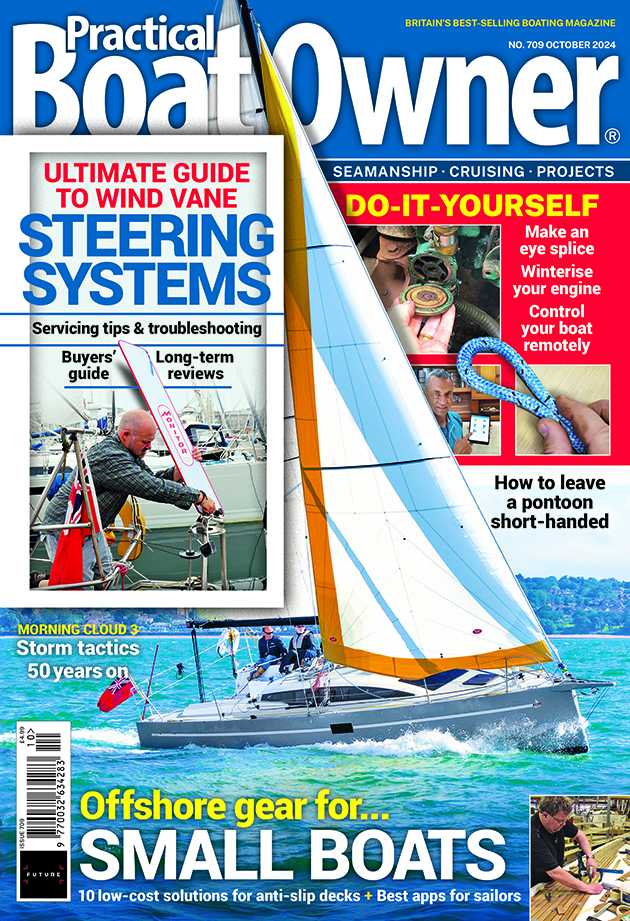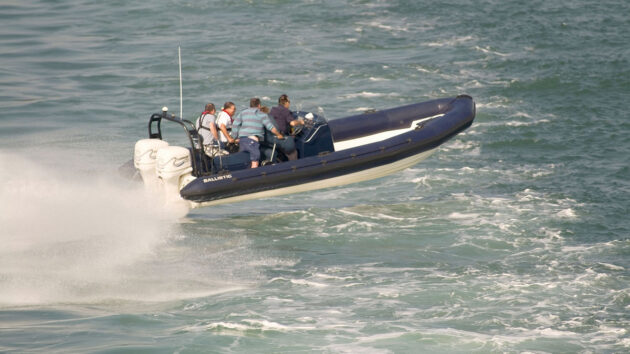Accumulative effects of shocks and impacts to boaters using small vessels at high speed or in rough water have been highlighted in an updated Maritime & Coastguard Agency (MCA) marine guidance note (MGN).
Amendment 4 of MGN 436 ‘Whole body vibration: guidance on mitigating against the effects of shocks and impacts on small vessels’, reflects on the evolving knowledge and best practice including the use of shock-mitigating technology and data.
Whilst the report paints a worse-case scenario, the good news is that there is a whole raft of technology available to give even the smallest boat a much smoother ride.

Thrills, with no ills. This tourist RIB is fitted with special impact-mitigating jockey seats from Scandinavian Suspension Seating Systems, providing a comfortable landing for the passengers
PBO’s regular contributor, Dr Gilbert Park, a long-time powerboater, wishes he had read this report before suffering a compression fracture during a Rigid Inflatable Boat (RIB) voyage 15 years ago.
Gilbert said: “Early on in my motorboat career, I decided to travel from Penzance to the Isles of Scilly in a small RIB. It wasn’t a pleasant trip and I kept telling my wife, who was helming, to go faster. So she did, twice flying the RIB off a wave.
“The impacts were hard and when we got to the St Marys all I could do was search for a pharmacy to buy some strong analgesics and the hotel so I could lie down for the next two days.
“I still suffer from the compression fracture from that day and the pain it causes.”
He added: “The report makes very good suggestions about how to mitigate the shock. I now intend to buy two shock-absorbing seats even though I now only have a motor cruiser.”

Seating is available as a complete unit, as shown by this retrofit kit from the US-based Smooth Move Seating

A popular and less expensive alternative is to move your existing seat to a new shock-absorbing base, as demonstrated by this Scandinavian 4S unit
Possible life-changing injuries
The MGN advises boaters to mitigate the risk of injury from whole body vibration (WBV) on small vessels, and in particular severe and repeated shocks (RS) as a result of impacts.
It states: “There have been a number of incidents involving small craft, travelling at a wide range of speeds, receiving predominantly vertical shock impact when coming off a wave, resulting in injury to one or more persons on board. The effects of crossing seas and side-on waves can also cause injury. Incidents have occurred on inland waters and estuaries as well as at sea.”

With outboard engines becoming more powerful, upgrade kits are available for the steering to give a better response, require less effort and with an adjustable wheel position. The wheels themselves are also more ergonomically designed. This is an upgrade kit for hydraulic steering from Italian specialists MaviMare & Mancini
Injuries sustained include spinal compression injuries, serious damage to joints and fractures in the leg and feet. The report said: “When such injuries occur, they can be life-changing.”
Current research suggests that there is no definitive design of craft or seating which is guaranteed to mitigate all the effects of WBV, but users tend to highlight the significant difference they can make to comfort and endurance. There are, however, some measures which may assist in reducing the effects, and the impact of the craft slamming.
Seating that supports good ‘posture and stability’ to mitigate the risk from shocks and impacts are recommended, along with handholds and foot-straps to help keep the spine straight.

The report suggests that passengers should be sitting upright and facing the direction of travel. This a cockpit design from the Swedish seat manufacturer Ullman. Note the adjuster handles on the seats and the well-positioned footrests
The report advises: “An upright posture, with the spine in neutral alignment (natural ‘S’ shape) should be maintained whilst facing in the direction of travel. Sitting or standing sideways should be avoided as this generally results in the occupant adopting a twisted upper body thus increasing the stress on the spine.”
Stern safety
By design, the vertical motion experienced onboard a powered craft is generally greater in the bow area than at the stern.
The report highlights that when small craft are designed with the driving position towards the stern with passenger seating in front, the driver has less exposure – and therefore mindfulness – to the vertical impacts on others on board.
Moving the helm position forward exposes the driver to the greatest forces, encouraging them to “adjust the speed and movement of the vessel accordingly”, however this increases the risk to those who spend extended time at the helm and limits the supervision of passengers behind.
Suspension seats should also be considered to “separate the occupant from the worst effects of vibration and impact, although the report warns: “An unsuitable suspension seat may increase rather than reduce exposures.”
Seatbelts could also help, although consideration should be given to how users can escape quickly in an emergency.
The in-depth report highlights how adjustable seat heights enable the occupant to firmly ground their feet on the deck, whilst foot pegs or land points for bracing.
Design measures

With the increasing need to improve fuel economy and comfort, a great deal of effort is being placed to make modern hulls efficient and ride well. This is a deep-Vee ‘stepped’ hull from Axopar, propelled by an Evoy electric outboard
The shape and hydrodynamic performance of the hull can reduce the impact of vertical movements.
A deep-V shape hull will cut through the water better than a flatter bottomed vessel. However, if a V hulled vessel heels significantly as it falls off a wave the vessel may land on a flatter section of the hull and a severe slam may still be experienced.
The reports states that “The use of multihulls, hydrofoils, active trim tabs, fins or interceptors may be considered with the intention of improving ride comfort.”
In fact, the increasingly compact and affordable nature of these items has increased their take-up, especially in much smaller craft, and is making a big difference by smoothing out the ride.

The use of foil technology is allowing very small boats to avoid wave impact altogether, as demonstrated by this electrically powered runabout from the Australian OEM ENautic. The flight control system is largely automatic
The report also mentions that “decks made of aluminium, fibreglass and composite materials transmit shocks and vibration.” Deck surfaces should be covered in a non-slip coating or grip material.
The authors suggest that standing on soft foam or rubber flooring may reduce vibration at low speed, however “these materials do not mitigate the effects of wave impacts and can lack stability, which causes fatigue.”
Adjustable steering controls should also be considered as “large ranges of movement can affect posture” – the report recommends: “where shock mitigation seats are fitted, mounting controls and/or displays on the armrests may be beneficial.”
Sensors can be fitted to provide real-time vibration data, which may encourage the driver to adjust the throttles to a more comfortable setting.

Seating that supports good ‘posture and stability’ to mitigate the risk from shocks and impacts are recommended, along with handholds and foot-straps to help keep the spine straight. Photo credit: gtzx/Alamy
Consider the more vulnerable
There are some people at special risk – those with thinned and brittle bones (osteoporosis) such as the elderly, taking medicines such as steroids that also thin bones as those who are pregnant or have other musculoskeletal problems.
Cold exposure may accelerate the onset or worsen the severity of back pain, plus the person’s ability to hold on and maintain good posture. The report recommends “warm, waterproof clothing.”
“Set your throttle for the conditions”

“Make sure your crew are always sitting comfortably, preferably on soft cushions, or sprung seats” advises Jake Kavanagh. Photo credit: Sergio Azenha/Alamy
PBO regular contributor Jake Kavanagh, former editor of Motor Boats Monthly, said: “Although the report makes for sober reading, the safest measure you can take is to apply some common sense.
“Flat bottomed boats tend to slam in a seaway, so simply set the throttle for the conditions. Avoid boating in weather that is marginal, and make sure your crew are always sitting comfortably, preferably on soft cushions, or sprung seats.
“Full suspension seat pedestals are easy to retrofit and start at just over £100. I would recommend fitting fast-acting trim tabs or interceptors, which automatically adjust many times a second to make the boat travel more smoothly.
“Also, on outboard or outdrive boats, experiment with the power trim and tilt to present the cleanest profile to the sea. (This type of ride control is one of the subjects covered in a Level 2 RYA Powerboat course).
“For those with deeper pockets, fitting some of the latest stabiliser technologies will make a big difference, not just underway, but also at anchor, virtually eliminating any roll.
“Bottom line – just drive sensibly for the conditions and equip for the rough stuff. Remember, it’s a boat, not a plane, so no need to get airborne.”
Read the report at: https://www.gov.uk/government/publications/mgn-436-mf-amendment-4-whole-body-vibration
Smoothing the cruising – a buyers guide to ‘shock-absorbing’ boat gear and more!
The ability to soften that slamming motion of a fast boat at sea has been greatly helped with more advanced…
Cruising in powerboats long distance: a quick guide
When cruising in powerboats, especially small open boats, safety is paramount. Jake Kavanagh shares his advice for relaxed high-speed adventures…
My first motorboat – two sailors on how and why they converted to powerboating
Retired doctor and practical motorboat owner Gilbert Park has undertaken numerous DIY challenges on board his various motorboats, publishing several…
How I built a bespoke aluminium powerboat at home
Late in 2015, just as James Oakley was finishing the hull of his home-built aluminium speedboat, he was diagnosed with…
Want to read more marine news stories?

A subscription to Practical Boat Owner magazine costs around 40% less than the cover price.
Print and digital editions are available through Magazines Direct – where you can also find the latest deals.
PBO is packed with information to help you get the most from boat ownership – whether sail or power.
-
-
-
- Take your DIY skills to the next level with trusted advice on boat maintenance and repairs
- Impartial in-depth gear reviews
- Practical cruising tips for making the most of your time afloat
-
-
Follow us on Facebook, Instagram, TikTok and Twitter








